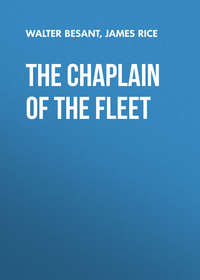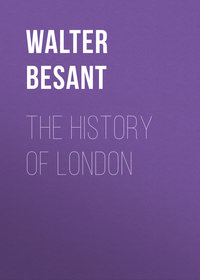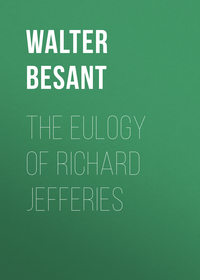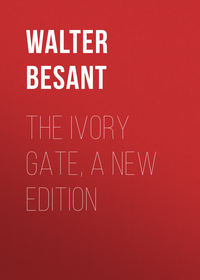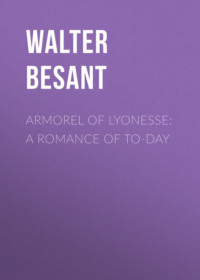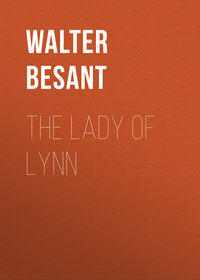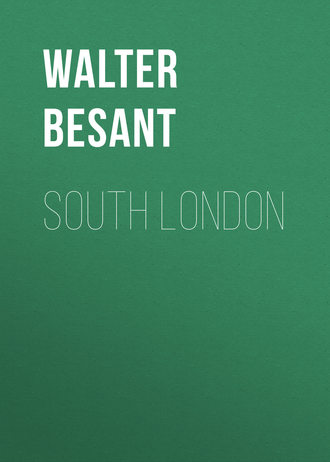 полная версия
полная версияSouth London
The place was essentially a suburb. There were no trades or industries in it, except that of fishing; the fishermen had their cottages dotted about all along the Embankment; a few watermen lived here, but that was perhaps later: other working men there were none, save the cooks and varlets of the great houses, and the 'service' of the inns. Because the air was fresh and pure, blown up daily with the tides; and because the place was easy of access, by river, to Westminster and the Court, many great men, ecclesiastics and nobles, had their town houses here: the Bishop of Winchester, the Bishop of Rochester, the Prior of Lewes, the Abbot of Hyde, the Abbot of Battle, the Earls of Surrey, Sir John Fastolfe, also the Brandons. Also, because it was easy of access by bridge and river to the City, the merchants brought their goods and warehoused them here in the inns at which they stayed, while they went across the river and transacted their business. It was a suburb which, in modern times, would be described as needing no poor rate. Later on there grew up, as we shall see, a class of the unclassed – a population of rogues and vagabonds, thieves, and sanctuary birds.
The government of the place as a whole was difficult, or rather impossible. There were several 'Liberties;' the Liberty of Bermondsey; that of the Bishop of Winchester; that of the King; that of the Mayor. The last contained the part of the Borough lying between St. Saviour's Dock on the west and Hay's Dock on the east, with a southern limit just including St. Margaret's Church. This very small district was called the Gildable Manor: it was conceded by the King to the City of London in the thirteenth century in order to prevent the place from becoming the home and refuge of criminals from the City. As the other liberties remained outside the jurisdiction of the City, the alleviation gained was not very great: criminals still dropped across the river, finding shelter on the Lambeth Marsh or the marsh between Bermondsey and Rotherhithe. It was from this unavoidable hospitality to persons escaping from justice that Southwark received a character which has stuck to it till the present day. In the centuries which include the twelfth to the fifteenth, however, South London, so far as it was populated at all, was the residence of great lords and the place of sojourn for merchants from the country. As yet the reputation of Southwark was spotless and its dignity enviable. London itself had no such collection of palaces gathered together so closely. As for the land, that lay low, but was protected by the Embankment from the river. Many rivulets flowed slowly across the misty meadows; many ponds lay about the flats; there was an abundant growth of trees everywhere, so that parts of the land were dark at midday by reason of the trees growing so close together. The rivulets were pretty little streams; willows grew over them; alders grew beside them; they were coloured brown by the peaty soil; on their banks grew wild flowers – the marsh mallow, the anemone, the hedgehog grass, the frogbit, the crowfoot, and the bitter-wort; orchards flourished in the fat and fertile soil. The people had almost forgotten the special need of their Embankment. Yet when, in the year 1242, the Embankment at Lambeth was broken down, the river rushed in and covered six square miles of country, including all that part which is now called Battersea.
Remember, however, that as yet there was not a single house upon the whole of Lambeth Marsh, nor upon the whole of Bermondsey Marsh. The houses began near what is now the south end of Blackfriars Bridge; they faced the river, having gardens behind them. On the other side of the Bridge the houses extended farther, going on nearly opposite to Wapping.
The place was well provided with prisons; every Liberty had its own prison. Thus there were the Clink of the Winchester Liberty, that of the Bermondsey Liberty, the 'White Lion' of Surrey, the King's Bench, and the Marshalsea, all in the narrow limits we have laid down. And there were also, for the delectation of the righteous and the terror of evil-doers, the visible instruments for correction. In every parish there was the whipping post – one in St. Mary Overy's churchyard, put up after the time of the monks; one at St. Thomas's Hospital; there was the pillory for neck and hands, generally with somebody on it, but the pillory was movable; there was the cage – one stood at the south end of the Bridge – women had to stand in the cage; there were stocks for feet wandering and trespassing; there were pounds for stray animals.
Markets were held in the churchyard of St. Margaret's; in the precinct of Bermondsey Abbey; and along the street called 'Long Southwark' – now High Street – from the Bridge to St. Margaret's Hill. But we must not suppose that the markets of Southwark presented the same crowded appearance, and were carried on with the same noise and bustle, as those of Chepe and Newgate on the other side.
Everything, in those days, was quiet and dignified in Southwark. The Princes of the Church arrived and departed, each with his retinue of chaplains and secretaries, gentlemen and livery. Kings and ambassadors rode up from Dover through Long Southwark and across the Bridge. The mayor and aldermen in new cloaks of red murrey and gold chains sallied forth to meet the King returning from abroad. Cavalcades of pilgrims for Canterbury, Compostella, Seville, Rome, and Jerusalem rode out of Southwark when the spring returned; and every day there arrived and departed long lines of packhorses laden with the produce of the country and with things imported for sale in London City. Pilgrims, merchants, travellers, all put up at the Southwark inns. The place was nothing but a collection of inns; the ecclesiastics stayed here for a few weeks and then went away; the great lords came here when they had business at Court and then went away again; the merchants came and went: by itself the place had, as yet, no independent life or character of its own at all.
There were two Monastic Houses. Both were stately; both are full of history. Let us consider the House of Bermondsey, because it is less generally known than the other of St. Mary Overy or Overies.
The Abbey of St. Saviour, Bermondsey, was the Westminster of South London. Like Westminster, Bermondsey stood upon a low islet in the midst of a marsh; at the distance of half a mile on the north ran the river; half a mile on the west was the Causeway; half a mile on the south was the Dover road. It is significant of the seclusion in which the House lay that the only road which connected it with the world was that lane called Bermondsey or Barnsie or Barnabie Lane, which ran from the Abbey to St. Olave's and so to London Bridge. It was not, like Westminster, a place of traffic and resort. It lay alone and secluded, separated from the noise and racket of life. When the marsh had been gradually drained and the Embankment continued through Rotherhithe to Deptford and beyond the Greenwich levels, the Abbey lands round the islet became extremely fertile and wooded and covered with sheep and cattle.
The House was founded in the year 1182 by one Ailwin Childe, a merchant of the City, an Alderman also and one of the ruling families of London. He was the son of an elder Ailwin, who was a member of that 'Knighten Guild' which, with all its members and all its property – the land which now forms the Ward of Portsoken – went over to the Priory of the Holy Trinity. Religion of a practical and real kind was therefore hereditary in the family. The elder Ailwin became a monk, the younger founded a monastery; his son, the third of the family of whom we know anything, became the first Mayor of London, and remained Mayor for twenty-four years – the rest of his life.
The whole of history from the ninth to the fifteenth century is full of a pathetic longing after a religious Order, if that could be found, of true and proved sanctity. One Order after the other arises; one after the other challenges respect for reputed holiness of a new and hitherto unknown kind: in fact, it commands the respect of the people who always admire voluntary privation of what they value so much – food and drink; it receives endowments, gifts, foundations of all kinds; it then departs from the ancient rule, and quickly loses its hold upon the people. This is the simple history of Benedictine, Franciscan, Cistercian, and all the rest. However, at the close of the eleventh century the Cluniac was in the highest repute for a rigid Rule, strictly kept: and for an austerity strictly enforced. It was a Cluniac House which Ailwin Childe set up in Bermondsey, and which Earl de Warren, who also founded the Cluniac House of Lewes, enriched.
This Priory, with thirty-seven other Houses, was an Alien owing obedience to the Abbot of Cluny. A large part of its revenues, therefore, was sent out of the country, and it received its Priors from abroad. In the reign of Henry the Fifth the growing dissatisfaction on account of the Alien Priories came to a head, and they were all suppressed, or at least cut off from obedience to the Mother Convent. The Priory of Bermondsey was therefore raised to the dignity of an Abbey, with an English Abbot, and so continued until the Dissolution.
The Abbey was one of the many places of pilgrimage dotted about round London – places accessible in a single day's journey. Thus there were the three shrines of Willesden, Muswell Hill, and Gospel Oak, each possessing an image of the Virgin to which miraculous powers were attributed. At Blackheath there was another holy shrine; at Bermondsey there was a Holy Rood which was daily visited in the summer by pious pilgrims from London. The Rood had been fished up from the Thames, and no one knew its history; but the merit of a pilgrimage to the Abbey and of prayers said before the shrine was considered very precious. It was, moreover, an easy pilgrimage. A boat taken below the Bridge would take the pilgrim over to the opposite shore in a few minutes, where a cross standing before a lane leading out of 'Short Southwark' showed him the way. It was but half a mile to the Abbey of St. Saviour and the Holy Rood.
'Go,' writes John Paston in 1465 to his mother, 'visit the Rood of North door and St. Saviour in Bermondsey among while ye abide in London; and let my sister Margery go with you to pray to them that she may have a good husband or she come home again.'
One can hardly expect that the Abbot of Cluny should resign this valuable possession without a remonstrance. He made, in fact, the strongest possible remonstrance. In 1457 he sent over three monks with orders to lay the case before the King, and to invite his attention especially to the papers showing the clear and indisputable right of the Mother Convent to the House of Bermondsey. These monks, in fact, did present their case to the King, with the documents. But no one heeded them; they could hardly get a hearing; no one replied to their arguments. This neglect was perhaps the cause why one of them died while in this country. The other two went home again, having accomplished nothing. One of them on the eve of their departure wrote a piteous letter to the Abbot of St. Albans: —
For the rest, be it known to you, my Lord, that after having spent four months and a half on our journey, and following our Right with the most serene Lord the King and his Privy Council, we have obtained nothing: nay, we are sent back very disconsolate, deprived of our Manors, our Pensions alienated, and, what is still worse, we are denied the obedience of all our Monasteries which are 38 in number: nor did our Legal Deeds, nor the Testimonies of your Chronicles avail us anything, and at length, after all our pleading and expenses, we return home moneyless, for in truth, after paying for what we have eaten and drunk, we have but five crowns left, to go back about 260 leagues. But what then? We will sell what we have: we will go on: and God will provide. Nothing else occurs to write to your Paternity: but that as we entered England with joy, so we depart thence with sorrow: having buried one of our Companions – viz. the Archdeacon, the youngest of our company. May he rest in Peace! Amen.
There is not at the present moment a single stone of this stately House visible, though there were many remains above ground one hundred years ago. It is a pity, because there is the association of two Queens, not to speak of many great Lords of state Functions, and of Parliaments, connected with this House secluded in the Marsh.
The first of the two Queens is Katharine of Valois, widow of Henry the Fifth. The story is the most romantic, perhaps, of all the stories connected with our line of sovereigns and Queens and Royal Princes. It is not a new story, and yet it is not so well known that any apology is needed for telling it once more.
Henry died August 31, 1422. His widow, Katharine, began to live in the seclusion fitted for her sorrow and her widowhood. Among her household, the office of Clerk to the Wardrobe was filled by a young and handsome Welshman named Owen Tudor, or Theodore. He was the son of a plain Welsh gentleman of slender means, if any, who was in the service of the Bishop of Chester. He distinguished himself at Agincourt in the following of some nobleman unknown. It has been said, with singular ignorance of the time, that he was a private soldier – that is, a man with a pike or a bow, dressed in a leather jerkin which the men threw off when the battle began. The opportunities for a common soldier to distinguish himself in such an action were few, nor do we ever hear of a king raising a man from the ranks, as Henry raised Owen Tudor, to the post of Esquire to the Body. It is possible, but most improbable, that Owen Tudor was regarded as a common soldier: since his father was a gentleman in the service of the Bishop of Chester, he himself would go to war as a gentleman in the service and wearing the livery of some noble lord.
In this way, however, his promotion began. When the King married, Owen Tudor was attached to the household of the Queen. After the death of Henry he accompanied the Queen and remained in her service as Clerk to the Wardrobe. In this office he had to buy whatever was wanted by the Queen – her silk, her velvet, her cloth of gold. He was therefore brought into much closer and more direct relation with the Queen than other officers of the household. He pleased her by his appearance, his accomplishments, and his manners. Tradition says that he danced very well. There is no reason to inquire by what attractions or accomplishments he pleased. The fact remains that he did please the Queen, and that so much that she consented to a secret marriage with him. It was a dangerous step for this Welsh adventurer to take: it was a step which would cover the Queen with dishonour should it become known. That the widow of the great and glorious Henry, chief captain of the age, should be able to forget her husband at all; should be capable of union with any lower man; should ally her royal line with that of a man who could only call himself gentleman after the fashion of Wales: would certainly be considered to bring dishonour on the King, the royal family, and the country at large.
The marriage was not found out for some years. The Queen must have been most faithfully and loyally served, because children cannot be born without observation. Owen Tudor must have conducted matters with a discretion beyond all praise. No doubt the ordinary members of the household knew nothing and suspected nothing, because several years passed before any suspicion was awakened. Three sons and one daughter, in all, were born. The eldest, Edmund of Hadham, was so called because he was born there; the second, Jasper, was of Hatfield; the third, Owen, of Westminster; the youngest, Margaret, died in infancy.
Suspicions were aroused about the time of the birth of Owen, which took place apparently before it was expected and without all the precautions necessary, in the King's House at Westminster. The infant was taken as soon as born to the monastery of St. Peter's, secretly. It is not likely that the Abbot received the child without full knowledge of his parents. He did take the child, however; and here the little Owen remained, growing up in a monastery, and taking vows in due time. Here he lived and here he died, a Benedictine of Westminster.
It would seem as if Humphrey, Duke of Gloucester, heard some whisper or rumour concerning this birth, or was told something about the true nature of the Queen's illness, for he issued a very singular proclamation, warning the world, generally, against marrying Queen dowagers, as if these ladies grew on every hedge. When, however, a year or so afterwards, the fourth child, Margaret, was born, Humphrey learned the whole truth: the degradation, as he thought it, of the Queen, who had stooped to such an alliance, and the humble rank and the audacity of the Welshman. He took steps promptly. He sent Katharine with some of her ladies to Bermondsey Abbey, there to remain in honourable confinement: he arrested Owen Tudor, a priest – probably the priest who had performed the marriage – and his servant, and sent all three to Newgate.
All three succeeded in breaking prison, and escaped. At this point the story gets mixed. The King himself, we are told, then a lad of fifteen, sent to Owen commanding his attendance before the Council. Why did they not arrest him again? Owen, however, refused to trust himself to the Council – was not Humphrey, Duke of Gloucester, one of them? He asked for a safe-conduct. They promised him one by a verbal message. Where was he, then, that all these messages should be sent backwards and forwards? I think he must have been in Sanctuary. He refused a verbal message, and demanded a written safe-conduct. This was granted him, and he returned to London. But he mistrusted even the written promise; he would not face the Council: he took refuge in the Sanctuary of Westminster, where they were afraid to seize him. And here for a while he remained. It is said that they tried to draw him out by sending old friends who invited him to the taverns outside the Abbey Precinct. But Owen would not be so drawn. He knew that Duke Humphrey would make an end of him if he could. He therefore remained where he was. I think that he must have had some secret understanding with the King; for one day, learning that Henry himself was with the Council, he suddenly presented himself and pleaded his own cause. The mild young king, tender on account of his mother, would not allow the case to be pursued, but bade him go free.
He departed; he made all haste to get out of an unwholesome air: he made for Wales. Here the hostility of Duke Humphrey pursued him still: he was once more arrested, taken to Wallingford, and placed in the Castle there a prisoner. From Wallingford he was transferred again to Newgate, he and his priest and his servant. Once more they all three broke prison, 'foully' wounding a warder in the achievement of liberty, and got back to Wales, choosing for their residence the mountainous parts into which the English garrisons never penetrated.
When the King came of age Owen Tudor was allowed to return, and was presented with a pension of £40 a year. It is remarkable, however, that he received no promotion, or rank; that he was never knighted; and that the title of Esquire was the only one by which he was known. It certainly seems as if the claim of Owen Tudor to be called a gentleman was not recognised by the King or the heralds. Perhaps Welsh gentility was as little understood by these Normans as Irish royalty – yet, so far as length of pedigree goes, both Welsh and Irish were very superior to Normans.
The two sons, Edmund and Jasper, were placed under the charge of Katharine de la Pole, Abbess of Barking, and sister of the Earl of Suffolk. When the King came of age he remembered his half-brothers: Edmund was made Earl of Richmond, Jasper Earl of Pembroke; both ranked before all other English Earls. Edmund was afterwards married to Margaret Beaufort, who as Countess of Richmond was the foundress of Christ's and St. John's Colleges, Cambridge. Her son, as everybody knows, was Henry VII.
As for Owen Tudor, that gallant adventurer, who began so well on the field of battle, ended as well, fighting, as he should, for his step-son and King, under the badge of the Red Rose. When the Civil Wars began he joined the King's forces, though he was then nearer seventy than sixty. He fought at Wakefield; he pursued the Yorkists to Mortimer's Cross, where another fight took place. The Lancastrians were defeated. Owen was taken prisoner, and was cruelly beheaded on the field. It was right and just that he should so fight and should so die. He survived his Queen twenty-four years.
The unfortunate Katharine, whose mésalliance gave us the strongest sovereigns we have ever had over us, did not long survive the disgrace of discovery. As to public knowledge of the fact, one cannot learn how widely it was extended. Probably it grew by degrees: chroniclers speak of it without reserve, and when the sons grew up and were acknowledged by the King there was no pretence at concealment. To be the son of a French Princess and a Welsh gentleman was not, after all, a matter for shame or concealment. Katharine carried down to the Abbey a disorder which she calls of long standing and grievous. It killed her in less than a year after her imprisonment among the orchards and meadows of the Precinct. It is said that her remorse during her last days was very deep; not for her second marriage, but for having allowed her accouchement of the King to take place at Windsor, a place against which she was warned by the astrologer. 'Henry of Windsor shall lose all that Henry of Monmouth shall win.' Alas! had Henry of Windsor been Henry of Monmouth himself, he would have lost all there was to lose. Could there be a worse prospect, had Katharine understood the dangers, of hereditary disease? On the one side the grandson of a leper and the son of a consumptive; on the other side, the grandson of a madman and a Messalina.
Katharine dictated her will a few days before her death. She asks for masses for her soul: for rewards for her servants: for her debts to be paid. And she says not one word about her children by Owen Tudor. She confesses by this silence that she is ashamed. She confesses by this silence that, being a Queen, and of a Royal House, she ought not in her widowhood to have been mated with any less than a King.
'I trustfully,' she says in the preamble, addressing her son the King, 'and am right sure, that among all creatures earthly ye best may and will best tender and favour my will, in ordaining for my soul and body, in seeing that my debts be paid and my servants guerdoned, and in tender and favourable fulfilment of mine intent.' The words are full of queenly dignity; but – where is the mention of her children? Perhaps, however, she knew that the King would provide for them.
Another Queen died here: the Queen 'to whom all griefs were known' – Elizabeth Woodville. It is not easy to feel much sympathy with this unfortunate woman, yet there are few scenes of history more full of pathos and of mournfulness than that in which her boy was torn from her arms; and she knew – all knew – even the Archbishops, when they gave their consent, knew – that the boy was to be done to death. When one talks of Queens and their misfortunes, it may be remembered that few Queens have suffered more than Elizabeth Woodville. In misfortune she sits apart from other Queens, her only companions being Mary Queen of Scots and Marie Antoinette. Her record is full of woe. But in that long war it seems impossible to find one single character, man or woman – unless it is King Henry – who is true and loyal. All – all – are perjured, treacherous, cruel, self-seeking. All are as proud as Lucifer. Murder is the friend and companion of the noblest lord; perjury walks on the other side of him; treachery stalks behind him: all are his henchmen. Elizabeth met perjury and treachery with intrigue and plot and counter-plot: she was the daughter of her time. She was accused of being privy to the plots of Lambert Simnel and Perkin Warbeck: she was more Yorkist than her husband; she hated the Red Rose long after the Red and the White were united by her daughter and Henry the Seventh. That she was suspected of these intrigues shows the character she bore. We must make allowance: she was always in a false position; Edward ought not to have married her; she was hated by her own party; she was compelled in the interests of her children to be always on the defensive; and in her conduct of defence she was the daughter of her age. These things, however, deprive her, somewhat, of the pity which we ought to feel for so many misfortunes.




